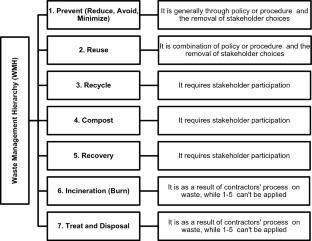审查建筑和拆除废物管理工具和框架,以及废物的分类、成因和影响
摘要
本综述通过对建筑和拆除废物(C&DWM)的定义、分类、成分、组成、产生来源和原因、产生的建筑和拆除废物(C&DWs)的影响、废物管理层次(WMH)、3R 原则(减少、再利用和再循环)、循环经济(CE)、框架、工具和方法的审查,对当前建筑和拆除废物管理(C&DWM)的情况进行了研究。在查阅文献后,本研究通过以下方式对文献做出了贡献:(a) 提供了适当的建筑与拆除工程和建筑与拆除工程管理的工作定义,(b) 提出了建筑与拆除作业的扩展 WMH,(c) 确定了建筑与拆除工程管理的框架,并将其列出如下:(c) 确定并列举了以下框架:基于 WMH 的框架(包括 3R 原则和 CE 概念),以量化、估算和预测所产生的 C&DW 为重点的框架,以有效和可持续的 C&DWM 为重点的框架,以经济、社会和环境绩效评估为重点的框架,基于多标准分析(MCA)的框架,基于灾后恢复期的框架,以及其他各种框架;DWM 中使用的四类工具,即 C&DWM 中使用的方法、C&DWM 中使用的信息技术(IT)工具、C&DWM 中使用的多标准决策分析(MCDA)工具和 C&DWM 技术。此外,本研究还发现,CE 和绿色评级系统(GRS)是被广泛使用的方法,建筑信息模型(BIM)、射频识别(RFID)、地理信息系统和大数据是被广泛使用的 IT 工具,层次分析法(Analytical Hierarchy Process)、FUZZY、TOPS(TOPS)、MCDA(Multi-riteria decision analysis,MCDA)、C&DWM 技术是被广泛使用的技术、分析层次流程、FUZZY、TOPSIS(通过与理想解决方案的相似性进行排序优先选择的技术)、加权求和、表达现实的消除和选择 II、表达现实的消除和选择 III、混合数据评估和 REGIME(REG)是在建筑和营运领域广泛使用的多重标准分析工具;DWM 中广泛使用的 MCA 工具,而预制建筑和模块化建筑则是广泛使用的 C&DWM 技术。此外,我们还注意到,分析网络过程(ANP)的应用以及 ANP、FUZZY 和 TOPSIS 工具的混合应用,虽然能产生更精确的结果,但在进行多重标准分析的文献中并未引起广泛关注。此外,以往的研究大多集中在对生成的 C&DW 进行估计,但由于可用的 C&DW 数据不足,对生成的 C&DW 的预测关注较少。这篇综述文章还有助于 C&DWM 从业人员、学者、利益相关者和承包商在管理 C&DW 时为 C&DWM 选择合适的框架和工具。


This review looks over the current construction and demolition waste management (C&DWM) situations by scrutinizing the definition, classification, components, compositions, generated sources and causes, impacts of generated construction and demolition wastes (C&DWs), waste management hierarchy (WMH), 3R principles (Reduce, Reuse, and Recycle), Circular Economy (CE), frameworks, tools, and approaches of C&DWM. After reviewing the literature this study contributes to the literature by the following means: (a) suitable working definitions of C&DW and C&DWM are provided, (b) an expanded WMH for construction and demolition operations is presented, (c) frameworks of C&DWM are identified and listed as follows: frameworks based on WMH, including 3R principles and CE concept, frameworks focusing on the quantification, estimation, and prediction of generated C&DW, frameworks focusing on effective and sustainable C&DWM, frameworks focusing economic, social, and environmental performance assessment, frameworks based on multi-criteria analysis (MCA), frameworks based on post-disaster recovery period, and other miscellaneous frameworks, and (d) four categories of tools utilized in C&DWM are identified and explained, namely, approaches employed in C&DWM, information technology (IT) tools employed in C&DWM, multi-criteria decision analysis (MCDA) tools employed in C&DWM, and C&DWM technologies. Moreover, this study also found that CE, and green rating system (GRS) are widely used approaches, Building Information Modeling (BIM), Radio Frequency Identification (RFID), Geographic Information System, and Big Data are the extensively used IT tools, Analytical Hierarchy Process, FUZZY, TOPSIS (Technique for Order Preference by Similarity to the Ideal Solution), Weighted Summation, Elimination and Choice Expressing the Reality II, Elimination and Choice Expressing the Reality III, Evaluation of Mixed Data, and REGIME (REG) are the widely used MCA tools in C&DWM, and Prefabricated Construction and Modular Construction are broadly used C&DWM technologies. Furthermore, it has been observed that the application of the Analytic Networking Process (ANP) and hybridization of ANP, FUZZY, and TOPSIS tools do not catch considerable attention in the literature for conducting MCA, although it yields more precise outcomes. Additionally, most previous research has focused on the estimation of generated C&DW, but less attention has been given to forecasting the generated C&DW due to inadequate available C&DW data. This review article also assists C&DWM practitioners, academics, stakeholders, and contractors in choosing appropriate frameworks and tools for C&DWM while managing C&DW.

 求助内容:
求助内容: 应助结果提醒方式:
应助结果提醒方式:


